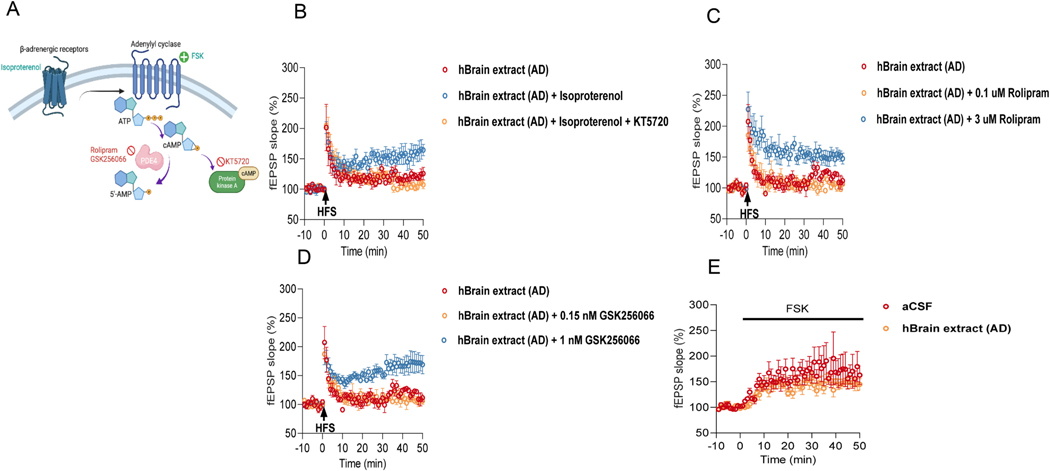Fig. 2.
Prevention of oAβ-impaired mf LTP by β-AR activation and its downstream cAMP-PKA signaling pathway. (A) Schematic illustration of presynaptic cAMP-PKA signaling pathway that respond to activation of βAR and the effects of some agonists (light blue) and antagonists (red). (B) The β-AR agonist isoproterenol (ISO, 1 μM) prevented the inhibition of LTP by oAβ (AD: 121.1 ± 5.07% n = 4 vs. AD with 1 μM ISO: 158.3 ± 14.05% n = 4, p = 0.027), but the LTP was blocked by applying PKA inhibitor KT5720 (1 μM) (AD with 1 μM ISO: 158.3 ± 14.05% n = 4 vs. AD with 1 μM ISO + 1 μM KT5720: 106.4 ± 2.76% n = 5, p = 0.003; one way ANOVA test). Each slice used for each treatment was from a different animal. (C) The PDE 4 inhibitor Rolipram (3 μM but not 0.1 μM) prevented the inhibition of LTP by AD (AD: 118.6 ± 4.38% n = 4 vs AD with 3 μM Rolipram: 150.8 ± 8.56%, n = 4, p = 0.008; AD: 118.6 ± 4.38% n = 4 vs AD with 0.1 μM Rolipram: 104.5 ± 1.95%, n = 4, p = 0.237; One way ANOVA test). Each slice used for each treatment was from a different animal. (D) GSK256066 (1 nM but not 150 pM) prevented the inhibition of LTP by AD (AD: 118.6 ± 4.38% n = 4 vs. AD with 1 nM GSK256066: 171 ± 16.12%, n = 4, p = 0.018; AD: 118.6 ± 4.38% n = 4 vs. AD2 with 150 pM GSK256066: 108 ± 5.51%, n = 3, p = 0.792; One way ANOVA test). Each slice used for each treatment was from a different animal. (E) Time course of mf-fEPSP slope potentiation induced by perfusion of forskolin (FSK, 5 μM) in control condition and in presence of 5% AD (Ctr: 167.9 ± 24.7% n = 5 vs AD: 146.7 ± 9.44% n = 4, p = 0.489; unpaired Student’s t-test). * p < 0.05, **p < 0.01.

